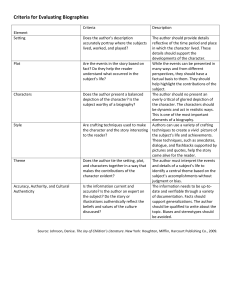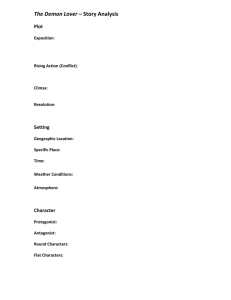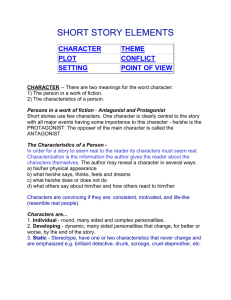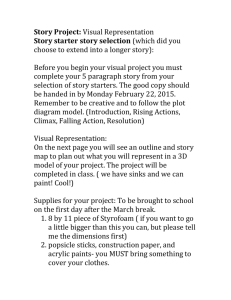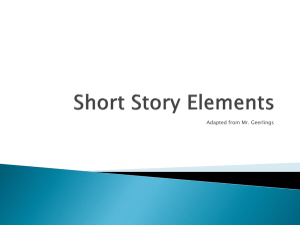SHORT STORY TIPS:
advertisement
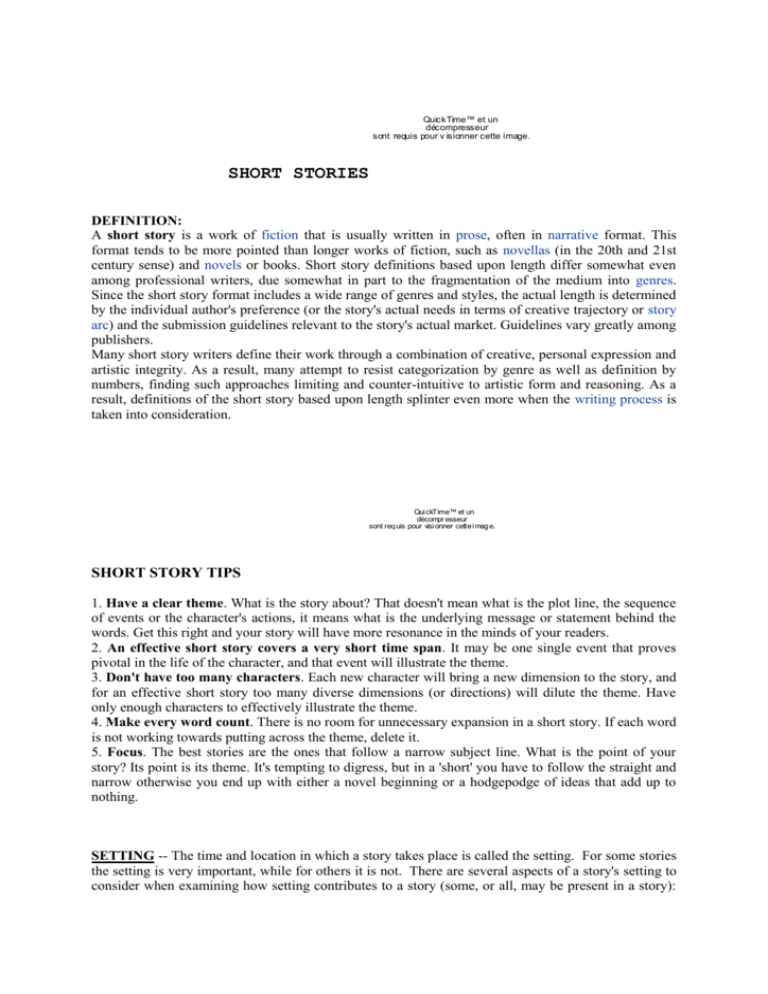
QuickTime™ et un décompresseur sont requis pour v isionner cette image. SHORT STORIES DEFINITION: A short story is a work of fiction that is usually written in prose, often in narrative format. This format tends to be more pointed than longer works of fiction, such as novellas (in the 20th and 21st century sense) and novels or books. Short story definitions based upon length differ somewhat even among professional writers, due somewhat in part to the fragmentation of the medium into genres. Since the short story format includes a wide range of genres and styles, the actual length is determined by the individual author's preference (or the story's actual needs in terms of creative trajectory or story arc) and the submission guidelines relevant to the story's actual market. Guidelines vary greatly among publishers. Many short story writers define their work through a combination of creative, personal expression and artistic integrity. As a result, many attempt to resist categorization by genre as well as definition by numbers, finding such approaches limiting and counter-intuitive to artistic form and reasoning. As a result, definitions of the short story based upon length splinter even more when the writing process is taken into consideration. Qui ckTime™ et un décompr esseur sont req uis pour visi onner cette i mag e. SHORT STORY TIPS 1. Have a clear theme. What is the story about? That doesn't mean what is the plot line, the sequence of events or the character's actions, it means what is the underlying message or statement behind the words. Get this right and your story will have more resonance in the minds of your readers. 2. An effective short story covers a very short time span. It may be one single event that proves pivotal in the life of the character, and that event will illustrate the theme. 3. Don't have too many characters. Each new character will bring a new dimension to the story, and for an effective short story too many diverse dimensions (or directions) will dilute the theme. Have only enough characters to effectively illustrate the theme. 4. Make every word count. There is no room for unnecessary expansion in a short story. If each word is not working towards putting across the theme, delete it. 5. Focus. The best stories are the ones that follow a narrow subject line. What is the point of your story? Its point is its theme. It's tempting to digress, but in a 'short' you have to follow the straight and narrow otherwise you end up with either a novel beginning or a hodgepodge of ideas that add up to nothing. SETTING -- The time and location in which a story takes place is called the setting. For some stories the setting is very important, while for others it is not. There are several aspects of a story's setting to consider when examining how setting contributes to a story (some, or all, may be present in a story): a) place - geographical location. Where is the action of the story taking place? b) time - When is the story taking place? (historical period, time of day, year, etc) c) weather conditions - Is it rainy, sunny, stormy, etc? d) social conditions - What is the daily life of the characters like? Does the story contain local colour (writing that focuses on the speech, dress, mannerisms, customs, etc. of a particular place)? e) mood or atmosphere - What feeling is created at the beginning of the story? Is it bright and cheerful or dark and frightening? PLOT -- The plot is how the author arranges events to develop his basic idea; It is the sequence of events in a story or play. The plot is a planned, logical series of events having a beginning, middle, and end. The short story usually has one plot so it can be read in one sitting. There are five essential parts of plot: a) Introduction - The beginning of the story where the characters and the setting is revealed. b) Rising Action - This is where the events in the story become complicated and the conflict in the story is revealed (events between the introduction and climax). c) Climax - This is the highest point of interest and the turning point of the story. The reader wonders what will happen next; will the conflict be resolved or not? d) Falling action - The events and complications begin to resolve themselves. The reader knows what has happened next and if the conflict was resolved or not (events between climax and denouement). e) Denouement - This is the final outcome or untangling of events in the story. It is helpful to consider climax as a three-fold phenomenon: 1) the main character receives new information 2) accepts this information (realizes it but does not necessarily agree with it) 3) acts on this information (makes a choice that will determine whether or not he/she gains his objective). CONFLICT-- Conflict is essential to plot. Without conflict there is no plot. It is the opposition of forces which ties one incident to another and makes the plot move. Conflict is not merely limited to open arguments, rather it is any form of opposition that faces the main character. Within a short story there may be only one central struggle, or there may be one dominant struggle with many minor ones. There are two types of conflict s: 1) External - A struggle with a force outside one's self. 2) Internal - A struggle within one's self; a person must make some decision, overcome pain, quiet their temper, resist an urge, etc. There are four kinds of conflicts: 1) Man vs. Man (physical) - The leading character struggles with his physical strength against other men, forces of nature, or animals. 2) Man vs. Circumstances (classical) - The leading character struggles against fate, or the circumstances of life facing him/her. 3) Man vs. Society (social) - The leading character struggles against ideas, practices, or customs of other people. 4) Man vs. Himself/Herself (psychological) - The leading character struggles with himself/herself; with his/her own soul, ideas of right or wrong, physical limitations, choices, etc. CHARACTERS -- There are two meanings for the word character: 1) The person in a work of fiction. 2) The characteristics of a person. Antagonist and Protagonist Short stories use few characters. One character is clearly central to the story with all major events having some importance to this character - he/she is the PROTAGONIST. The opposer of the main character is called the ANTAGONIST. The Characteristics of a Person - In order for a story to seem real to the reader its characters must seem real. Characterization is the information the author gives the reader about the characters themselves. The author may reveal a character in several ways: a) his/her physical appearance b) what he/she says, thinks, feels and dreams c) what he/she does or does not do d) what others say about him/her and how others react to him/her Characters are convincing if they are: consistent, motivated, and life-like (resemble real people) Characters are... 1. Individual - round, man- sided and complex personalities. 2. Developing - dynamic, many sided personalities that change, for better or worse, by the end of the story. 3. Static - Stereotype, have one or two characteristics that never change and are emphasized e.g. brilliant detective, drunk, scrooge (tight-fisted), cruel stepmother, etc. POINT OF VIEW : (narrative) Point of view, or p.o.v., is defined as the angle from which the story is told. 1. Innocent Eye - The story is told through the eyes of a child (his/her judgment being different from that of an adult) . 2. Stream of Consciousness - The story is told so that the reader feels as if they are inside the head of one character and knows all their thoughts and reactions. 3. First Person - The story is told by the protagonist or one of the characters who interacts closely with the protagonist or other characters (using pronouns I, me, we, etc). The reader sees the story through this person's eyes as he/she experiences it and only knows what he/she knows or feels. 4. Omniscient- The author can narrate the story using the omniscient point of view. He can move from character to character, event to event, having free access to the thoughts, feelings and motivations of his characters and he introduces information where and when he chooses. There are two main types of omniscient point of view: a) Omniscient Limited - The author tells the story in third person (using pronouns they, she, he, it, etc). We know only what the character knows and what the author allows him/her to tell us. We can see the thoughts and feelings of characters if the author chooses to reveal them to us. b) Omniscient Objective – The author tells the story in the third person. It appears as though a camera is following the characters, going anywhere, and recording only what is seen and heard. There is no comment on the characters or their thoughts. No interpretations are offered. The reader is placed in the position of spectator without the author there to explain. The reader has to interpret events on his own. THEME -- It is the author's underlying meaning or main idea that he is trying to convey. The theme may be the author's thoughts about a topic or view of human nature. The title of the short story usually points to what the writer is saying and he may use various figures of speech to emphasize his theme, such as: symbol, allusion, simile, metaphor, hyperbole, or irony. Some simple examples of common them es from literature, TV, and film are: - things are not always as they appear to be - Love is blind Believe in yourself - People are afraid of change - Don't judge a book by its cover. Qui ckTime™ et un décompr esseur sont req uis pour visi onner cette i mag e. QuickTime™ et un décompresseur sont requis pour visionner cette image. When you read a story, and before you begin writing an analysis, you should examine the various elements of the story and ask yourself specific questions: 1. Setting: Where and when is the story set? Is the setting significant? If so, why? For example, Count Leo Tolstoy’s “Master and Man” is set during a Russian winter in a blinding snowstorm, and the weather is crucial because the entire story revolves around it. 2. Character: Who are the main characters? (Look beyond the obvious.) What makes these characters act as they do and say what they say? What is their motivation? How do other characters relate to them? Is there more to them than meets the eye? For instance, in Tolstoy’s story, the two human characters are important but so is the weather, and, for that matter, so is the little horse, and without any one of these four characters, there would be no story. 3. Mood: How does story make you feel: happy, nostalgic, revolted, or frightened, etc? How does the mood relate to the story’s meaning? On the other hand, is the writer using irony, and if so, does this sense of incongruity help establish the mood? For example, as pointed out by Edward Proffitt, author of Reading & Writing About Literature, in Somerset Maugham’s “Appointment in Samarra,” Maugham uses dramatic irony to create a sense of divergence between what the servant believes and what the reader knows will happen” (1990, p.155). 4. Symbolism: Does anything in the story – an object, person, animal, detail, etc. – represent something other than what it appears to be on the surface? If so, how does this symbolic representation function within the story? For instance, in Herman Melville’s classic novel Moby Dick, the giant white whale with which Captain Ahab is obsessed is not merely a whale but, according to various interpretations, either Mother Nature or the Lord God of Israel. 5. Style: Look at the writer’s sentence structure and vocabulary. Does he or she use long, convoluted sentences like William Faulkner or short, concise sentences like Ernest Hemingway? What about figurative language? Does the writer use analogies, similes (comparisons), or metaphors? If so, for what purpose does he or she use them? 6. Theme: What is the underlying meaning of the story? Why do you think this? What evidence from the story supports your deduction? Remember, though, that readers often perceive different themes, and even when they see the same themes, they often have varying interpretations. For example, in Kate Chopin’s “The Story of an Hour,” one reader might broadly describe the theme as “marriage” while another might more specifically describe it as “the constraints of marriage on individual freedom” List of Short stories: To have an idea, here’s a list of famous short stories: http://www.classicshorts.com/bib.html and more here, with the main plot summarized: “The Lesson” – Toni Cade Bambara Miss Moore takes Sylvia and other neighborhood kids to an expensive toy store to teach the value of money and its unfair distribution in society. Sylvia, the narrator, uses rich, colorful language – colloquialisms, slang and curse words – to reveal inside information about the children’s lives, and that they not only hate Miss Moore and her “lessons,” but they actually get what she’s trying to teach them. “Neighbors” – Raymond Carver When the Stones ask the Millers to house sit for them, it becomes the Millers’ own “vacation” that sparks their sexual desire for each other, prompts them to shut out reality and reveals their jealously of the Stones. The Millers go through the Stones’ things, eat their food, drink their alcohol, take their pills and even try on their clothes. “The Story of an Hour” – Kate Chopin Irony abounds in this story as Mrs. Mallard celebrates the freedom that will come with her husband’s death, rather than grieves. Allusions to her weak heart foreshadow what happens when she learns that her husband is actually alive. “A Rose for Emily” – William Faulkner All that is known about reclusive Emily is hearsay: her strange behavior when her father dies, her relationship with a man from the North and her purchase of arsenic at the drug store. When Emily dies, the townspeople discover something gruesome in her bedroom, and we finally learn what she did with that arsenic. “Araby” – James Joyce A boy promises the older girl that he is in love with that he will bring her something back from a bazaar. The bazaar is closing by the time he gets there, so he can’t get the girl a present. The narrator is the boy all grown up looking back on an event that is colored with familial, religious and political symbols and images. “A Hunger Artist” – Franz Kafka The artist’s fasting is at first celebrated. When he joins a circus, people start to lose interest and his feat is unacknowledged. “A Good Man is Hard to Find” – Flannery O’Connor While on a road trip with her son and his family, an elderly lady tells her grandchildren about an old plantation and then convinces her son to turn down a dirt road to get to it. Her cat jumps out of its hiding place, causing the car to crash. An escaped convict comes to the family’s aid, and the unexpected ending reveals the true meaning of the title. “First Confession” – Frank O’Connor On the surface, this is a cute, humorous story of 7-year-old Jackie, who fights with his sister, hates his grandmother and is terrified about making his first confession. A closer look reveals that the narrator is likely this boy grown up reflecting on his past by showing disdain for women and religion. “A&P” – John Updike Sammy is a 19-year-old bored cashier until girls in bikinis walk into the store. He is immature and makes fun of customers and co-workers, and ogles the girls. When the store manager reprimands the girls for their attire, Sammy, highly offended, quits his job, hoping to be the girls’ knight in shining armor. “Everyday Use” – Alice Walker Dealing with heritage, culture and generation gaps, this story focuses on Mama and her two daughters, Maggie and Dee, who comes for a visit to inquire about a quilt that has been in the family for several generations. The story is packed with symbolism showing the many divisions that can exist in one family.

